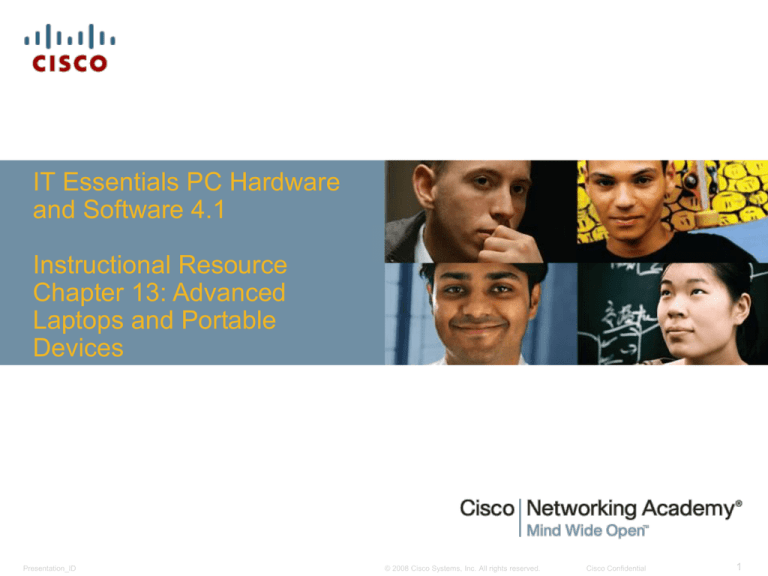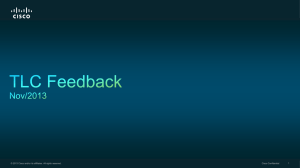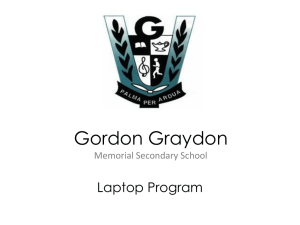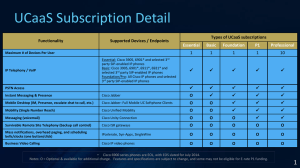
IT Essentials PC Hardware
and Software 4.1
Instructional Resource
Chapter 13: Advanced
Laptops and Portable
Devices
Presentation_ID
© 2008 Cisco Systems, Inc. All rights reserved.
Cisco Confidential
1
Chapter 13: Objectives
Describe wireless communication methods for laptops and portable devices.
Describe repairs for laptops and portable devices.
Select laptop components.
Describe preventive maintenance procedures for laptops.
Describe how to troubleshoot a laptop.
Presentation_ID
© 2008 Cisco Systems, Inc. All rights reserved.
Cisco Confidential
2
Chapter 13: Critical Concepts
What is this chapter about and why is it important?
Laptops, notebooks, netbooks, nettops, and other small portable computers are
becoming commonplace in both the business and home environment. These
devices have all the same components as a desktop computer, but in a smaller
footprint, with lower capacities, less powerful processors, more use of wireless
communications, and their own set of issues. When dealing with these laptop
matters, the theory is the same as when dealing with desktop memory, hard drives,
processors, and other hardware. However, the implementation is different. In this
chapter, students are exposed to more information about wireless communication,
laptop repairs, and common laptop problems and solutions.
Presentation_ID
© 2008 Cisco Systems, Inc. All rights reserved.
Cisco Confidential
3
Chapter 13: Activities
What activities are associated with this chapter?
13.2 Worksheet: Investigating Repair Centers
13.3.1 Worksheet: Laptop Batteries
13.3.2 Worksheet: Docking Station
13.3.3 Worksheet: Research DVD Drive
13.3.4 Worksheet: Laptop RAM
13.5.3 Worksheet: Verify Work Order Information
13.5.3 Worksheet: Investigating Support Websites and Repair Companies
13.5.3 Optional Lab: Troubleshooting Laptop Problems in Windows XP
13.5.3 Optional Lab: Troubleshooting Laptop Problems in Windows Vista
Chapter 13 Quiz
Presentation_ID
© 2008 Cisco Systems, Inc. All rights reserved.
Cisco Confidential
4
Chapter 13: New Terms
What terms are introduced in this chapter?
Presentation_ID
broadband optical telepoint
13.1.2
Customer Replaceable Unit (CRU)
13.2
Field-Replaceable Unit (FRU)
13.2
Flash memory
13.3.3
IEEE 802.15.1
13.1.1
infrared (IR)
13.1.2
infrared scatter
13.1.2
laptop connector
13.3.2
line of sight
13.1.2
Personal Digital Assistant (PDA)
13.1.2
© 2008 Cisco Systems, Inc. All rights reserved.
Cisco Confidential
5
Chapter 13: New Terms (continued)
What terms are introduced in this chapter?
Presentation_ID
port replicator
13.3.2
satellite communication
13.1.5
Small Outline DIMM (SODIMM)
13.3.4
Virtual Private Network (VPN)
13.1.4
Wi-Fi
13.1.4
Wi-Fi Protected Access (WPA)
13.1.4
Wired Equivalent Privacy (WEP)
13.1.4
wireless connection
13.1
© 2008 Cisco Systems, Inc. All rights reserved.
Cisco Confidential
6
Chapter 13: Changes
What has changed from the previous version (4.0) of ITEPC?
Page 13.1.1 Describe Bluetooth technology
• Bluetooth 1.0, 1.2, 2.0, and 3.0
Page 13.1.3 Describe cellular WAN technology
• Cellular WAN Generations
Page 13.3.3 Select storage devices
• Hard drives
• Optical drives
Page 13.3.4 Select additional RAM
• SODIMM installation
Presentation_ID
© 2008 Cisco Systems, Inc. All rights reserved.
Cisco Confidential
7
Chapter 13: Changes (continued)
What has changed from the previous version (4.0) of ITEPC?
Page 13.5.1 Review the troubleshooting process
• Identify the Problem
• Establish a Theory of Probable Causes
• Determine an Exact Cause
• Implement a Solution
• Verify Solution and Full System Functionality
• Document Findings
Presentation_ID
© 2008 Cisco Systems, Inc. All rights reserved.
Cisco Confidential
8
Chapter 13: Changes (continued)
What has changed from the previous version (4.0) of ITEPC?
Page 13.5.2 Identify common problems and solutions
• Know how to replace the hard drive, memory, and optical drive.
• Understand the disassembly processes for proper re-assembly.
• Document and label cable and screw locations.
• Organize parts.
• Refer to the manufacturer’s documentation.
• Use appropriate hand tools.
• Recognize internal laptop expansion slot types.
• Upgrade wireless cards and the video card.
• Know how to replace laptop parts.
•Keyboard and pointer devices
•System board and processor
•Plastics
•Heat sinks and fans
•CMOS battery
•Speakers
Presentation_ID
© 2008 Cisco Systems, Inc. All rights reserved.
Cisco Confidential
9
Chapter 13: Changes (continued)
What has changed from the previous version (4.0) of ITEPC?
Page 13.5.3 Apply troubleshooting skills
• Verify work order information.
• Investigate support websites and repair companies.
Presentation_ID
© 2008 Cisco Systems, Inc. All rights reserved.
Cisco Confidential
10
Chapter 13: Classroom Management
Obtain old and broken laptops from advisory committee members, parents,
students, the school, administrators, and fellow instructors to use in the classroom.
Allow students to disassemble these old and broken laptops for part identification.
Even if only one laptop is available, use it to demonstrate the laptop parts and the
troubleshooting procedure if possible.
Use scenario-based discussions about laptop problems. Have students bring in a
laptop problem. The class could solve the laptop problems together using
collaborative techniques and the Internet. Use the graphics on 13.5.2 to lead your
discussions.
Presentation_ID
© 2008 Cisco Systems, Inc. All rights reserved.
Cisco Confidential
11
Chapter 13: Teaching Analogies
Operating a laptop on battery power with all devices, including the wireless NIC, is
like turning on every electrical light and appliance in your house when the entire
residence is powered by a generator. You will run out of power quickly.
Presentation_ID
© 2008 Cisco Systems, Inc. All rights reserved.
Cisco Confidential
12
Chapter 13: Suggested Class
Discussions
What are some different types of laptop security and security devices?
What are some laptop travel tips for storing batteries, going though airport
security, and using the computer on airplanes?
What are some different types of hot swappable devices and laptop components?
What are some issues related to repairing laptop hardware at the customer site?
What are some advantages and disadvantages of using Bluetooth technology?
Presentation_ID
© 2008 Cisco Systems, Inc. All rights reserved.
Cisco Confidential
13
Chapter 13: Best Practices
Laptops and battery life are a common source of issues for users. Have the
students bring in three suggestions for prolonging the operation time of the laptop
battery during a single session of laptop use.
Research laptop problems on the Internet before class. Bring the problems to class,
have the students divide into teams, and give each team a problem. Tell one half of
the team the solution. Have the other half of the team ask questions in order to
arrive at a solution. For example, a laptop is running out of memory and
experiencing errors. One half of the team could ask, how many applications are
open when this occurs? The other side of the team answers based on what they
know.
Search on the Internet for the following term to get help from sites for laptop repair:
laptop disassembly guide.
Presentation_ID
© 2008 Cisco Systems, Inc. All rights reserved.
Cisco Confidential
14
Chapter 13: Outside Reading
Search the Internet for popular Laptop brands
Bluetooth:
http://www.bluetooth.com/English/Pages/default.aspx
802.11 from IEEE:
http://www.ieee802.org/11/
Presentation_ID
© 2008 Cisco Systems, Inc. All rights reserved.
Cisco Confidential
15
Presentation_ID
© 2008 Cisco Systems, Inc. All rights reserved.
Cisco Confidential
16
Presentation_ID
© 2008 Cisco Systems, Inc. All rights reserved.
Cisco Confidential
17








